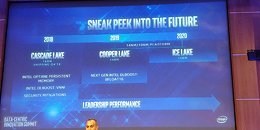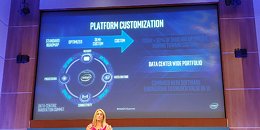Thursday, August 9th 2018

Intel "Cooper Lake" Latest 14nm Stopgap Between "Cascade Lake" and "Ice Lake"
With no end to its 10 nm transition woes in sight (at least not until late-2019), Intel is left with refinement of its existing CPU micro-architectures on the 14 nanometer node. The client-desktop segment sees the introduction of the "Whiskey Lake" (aka Coffee Lake Refresh) later this year; while the enterprise segment gets the 14 nm "Cascade Lake." To its credit, Cascade Lake introduces a few major platform innovations, such as support for Optane Persistent Memory, silicon-level hardening against recent security vulnerabilities, and Deep Learning Boost, which is hardware-accelerated neural net building/training, and the introduction of VNNI (Variable Length Neural Network Instructions). "Cascade Lake" makes its debut towards the end of 2018. It will be succeeded in 2019 by Ice Lake the new "Cooper Lake" architecture.
"Cooper Lake" is a refresh of "Cascade Lake," and a stopgap in Intel's saga of getting 10 nm right, so it could build "Ice Lake" on it. It will be built on the final (hopefully) iteration of the 14 nm node. It will share its platform with "Cascade Lake," and so Optane Persistent Memory support carriers over. What's changed is the Deep Learning Boost feature-set, which will be augmented with a few new instructions, including BFLOAT16 (a possible half-precision floating point instruction). Intel could also be presented with the opportunity to crank up clock speeds across the board.
Source:
Anandtech
"Cooper Lake" is a refresh of "Cascade Lake," and a stopgap in Intel's saga of getting 10 nm right, so it could build "Ice Lake" on it. It will be built on the final (hopefully) iteration of the 14 nm node. It will share its platform with "Cascade Lake," and so Optane Persistent Memory support carriers over. What's changed is the Deep Learning Boost feature-set, which will be augmented with a few new instructions, including BFLOAT16 (a possible half-precision floating point instruction). Intel could also be presented with the opportunity to crank up clock speeds across the board.


25 Comments on Intel "Cooper Lake" Latest 14nm Stopgap Between "Cascade Lake" and "Ice Lake"
I wonder if Intel will break out the soldering machine for this one...
Tesla has rising share prices and revenues too, doesnt mean the company isnt on massively shaky ground going forward. Same applies here. If intel cant get a new arch and new process off of the ground, AMD could end up catching or even passing them in a few years time. The MCM approach to CPUs is proving to scale better with multi core then intels monolith, and AMD's continued efforts to combat inter chip latency is proving fruitful.
You really cant call it a "rush" when 10nm is now 3 years, looking to be 4 years late. At that point we call it "get your act together".
It just happens that Intel wants to add an extra layer of patterning to draw smaller features. They feel the pain right now, but going forward everybody else will need that extra layer at some point. And then the tables will be turned.
They're in a tough spot, no doubt about that. But the manufacturing process could turn out to be a boon, once they get past their troubles.
As for "slightly better", you do know what a log scale is, don't you?
That graph only shows the _projected 2018 iteration_ of 10nm would be performing below the third 14nm iteration. That's already outdated, but if you compare similar iterations of 14 and 10nm, 10nm is still supposed to be better.
"broken and can't be fixed" - even if true, you can't know that now.
10nm+ Icelake Quad channels coming out Q3 2020.
14nm+++ CopperLake 9th Gen Q3 2019
14nm+++ CascadeLake 8 Gen Q4 2018 (28 Cores 5GHz) upcoming ASUS ROG Rampage VII board will be interesting.